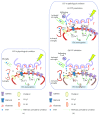Tumor Necrosis Factor and Interleukin-1 β Modulate Synaptic Plasticity during Neuroinflammation
- PMID: 29861718
- PMCID: PMC5976900
- DOI: 10.1155/2018/8430123
Tumor Necrosis Factor and Interleukin-1 β Modulate Synaptic Plasticity during Neuroinflammation
Abstract
Cytokines are constitutively released in the healthy brain by resident myeloid cells to keep proper synaptic plasticity, either in the form of Hebbian synaptic plasticity or of homeostatic plasticity. However, when cytokines dramatically increase, establishing a status of neuroinflammation, the synaptic action of such molecules remarkably interferes with brain circuits of learning and cognition and contributes to excitotoxicity and neurodegeneration. Among others, interleukin-1β (IL-1β) and tumor necrosis factor (TNF) are the best studied proinflammatory cytokines in both physiological and pathological conditions and have been invariably associated with long-term potentiation (LTP) (Hebbian synaptic plasticity) and synaptic scaling (homeostatic plasticity), respectively. Multiple sclerosis (MS) is the prototypical neuroinflammatory disease, in which inflammation triggers excitotoxic mechanisms contributing to neurodegeneration. IL-β and TNF are increased in the brain of MS patients and contribute to induce the changes in synaptic plasticity occurring in MS patients and its animal model, the experimental autoimmune encephalomyelitis (EAE). This review will introduce and discuss current evidence of the role of IL-1β and TNF in the regulation of synaptic strength at both physiological and pathological levels, in particular speculating on their involvement in the synaptic plasticity changes observed in the EAE brain.
Figures


Similar articles
-
miR-142-3p Is a Key Regulator of IL-1β-Dependent Synaptopathy in Neuroinflammation.J Neurosci. 2017 Jan 18;37(3):546-561. doi: 10.1523/JNEUROSCI.0851-16.2016. J Neurosci. 2017. PMID: 28100738 Free PMC article.
-
Inflammation subverts hippocampal synaptic plasticity in experimental multiple sclerosis.PLoS One. 2013;8(1):e54666. doi: 10.1371/journal.pone.0054666. Epub 2013 Jan 23. PLoS One. 2013. PMID: 23355887 Free PMC article.
-
Synaptic plasticity in multiple sclerosis and in experimental autoimmune encephalomyelitis.Philos Trans R Soc Lond B Biol Sci. 2013 Dec 2;369(1633):20130162. doi: 10.1098/rstb.2013.0162. Print 2014 Jan 5. Philos Trans R Soc Lond B Biol Sci. 2013. PMID: 24298163 Free PMC article. Review.
-
Interleukin-1β causes excitotoxic neurodegeneration and multiple sclerosis disease progression by activating the apoptotic protein p53.Mol Neurodegener. 2014 Dec 12;9:56. doi: 10.1186/1750-1326-9-56. Mol Neurodegener. 2014. PMID: 25495224 Free PMC article.
-
Mechanisms of homeostatic plasticity in the excitatory synapse.J Neurochem. 2016 Dec;139(6):973-996. doi: 10.1111/jnc.13687. Epub 2016 Jul 1. J Neurochem. 2016. PMID: 27241695 Review.
Cited by
-
An emerging role for microglia in stress-effects on memory.Eur J Neurosci. 2022 May;55(9-10):2491-2518. doi: 10.1111/ejn.15188. Epub 2021 May 4. Eur J Neurosci. 2022. PMID: 33724565 Free PMC article. Review.
-
The brain cytokine orchestra in multiple sclerosis: from neuroinflammation to synaptopathology.Mol Brain. 2024 Jan 23;17(1):4. doi: 10.1186/s13041-024-01077-7. Mol Brain. 2024. PMID: 38263055 Free PMC article. Review.
-
Cognitive impairment in multiple sclerosis: lessons from cerebrospinal fluid biomarkers.Neural Regen Res. 2021 Jan;16(1):36-42. doi: 10.4103/1673-5374.286949. Neural Regen Res. 2021. PMID: 32788445 Free PMC article.
-
Neuro-Immune Cross-Talk in the Striatum: From Basal Ganglia Physiology to Circuit Dysfunction.Front Immunol. 2021 Apr 19;12:644294. doi: 10.3389/fimmu.2021.644294. eCollection 2021. Front Immunol. 2021. PMID: 33953715 Free PMC article. Review.
-
Intermittent systemic exposure to lipopolysaccharide-induced inflammation disrupts hippocampal long-term potentiation and impairs cognition in aging male mice.Brain Behav Immun. 2023 Feb;108:279-291. doi: 10.1016/j.bbi.2022.12.013. Epub 2022 Dec 19. Brain Behav Immun. 2023. PMID: 36549577 Free PMC article.
References
Publication types
MeSH terms
Substances
LinkOut - more resources
Full Text Sources
Other Literature Sources
Medical

